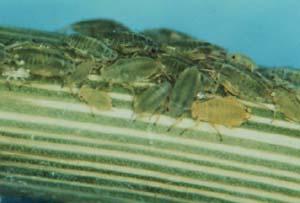Fruit Problems
Maggots
Cause
The blueberry maggot (Rhagoletis mendex), the immature form of a black fly which resembles a small housefly (except with striped black and white wings). Adult flies lay eggs in fruit which hatch into maggots, and begin feeding inside the berries. Infested fruit is not harmful to eat, but is unappealing.
Treatment
Many processors have a zero tolerance threshold for blueberry maggots. Therefore populations of adult flies should be monitored closely. Yellow sticky traps placed throughout blueberry fields, just above bush canopies starting in early June can provide a good indication of adult populations. When adult flies are detected, chemical control should be initiated and continued for the duration of the fruiting season.
Shriveled, Pinkish Berries
Cause
Mummyberry (Monilinia vacinii-corymbosi), a fungal disease. Left unpicked, diseased berries will fall to the ground creating inoculum which may affect emerging leaf buds and berries the following season. Up to 40% crop loss may occur if mummyberry is left untreated over several seasons.
Treatment
No resistant varieties are available. Remove nearby wild blueberry plants, and remove and discard fallen berries. Various fungicides are available. Follow the manufacturer's instructions with each of these products.
Soft berries with a slimy, orange substance
Cause
Anthracnose fruit rot (Colletotrichum acutatum), a fungal disease characterized by softening berries and slimy orange spore masses. Infection commonly occurs during bloom, and is facilitated by rain.
Treatment
Plant disease resistant varieties. Prune out old wood. Avoid excessive and early morning irrigation.
Fuzzy, dark green mold
Cause
Alternaria fruit rot (Alternaria tenuissima), a fungal disease.
Treatment
Plant disease resistant varieties. Prune out old wood. Avoid excessive and early morning irrigation.
Leave, Foilage, and Stem Problems
Curled leaves, insect cocoons, or deformed leaves and fruit
Cause
Leafrollers (Tortricidae family), the caterpillars of various moth species. These caterpillars are generally green or brown and less than 1 inch in length. Leafrollers feed on flowers, young fruit, and leaves, then form cocoons within rolled-up leaves. Up to two generations may occur during a single growing season.
Treatment
Initiate chemical control when average populations exceed 15 caterpillars per plant. Care should be taken to avoid the use of pesticides during the bloom when bees are present for pollination.
Yellow leaves, with a shiny or sticky substance on surface

Cause
Aphids (various species). These small soft-bodied insects are less than 1/8 inch long and appear in a variety of colors. Using piercing-sucking mouth parts, aphids remove plant sap and often spread disease in the process. Ants are often drawn to their sticky excrement.
Treatment
Fruit is rarely damaged. Many natural predators such as lady beetles exist. However aphids vector the harmful Blueberry Shoestring Virus, therefore action may be necessary. Low toxicity insecticidal soaps and horticultural oils are highly effective.
Misshapen or red-streaked leaves
Cause
The Blueberry shoestring virus, a viral disease spread by aphids.
Treatment
Plant only virus resistant varieties and disease-free stock. Inspect plants often and remove any plants showing symptoms. Control aphid populations.
Bull's eye lesions on the lower stem
Cause
Fusicoccum canker (Fusicoccum putrefaciens), a fungal disease. Spores of this fungus are spread during wet and windy conditions.
Treatment
Plant disease resistant varieties. Prune out and destroy any dead or diseased canes.
Reddish leaves on wilting canes
Cause
Phomopsis twig blight (Phomopsis vaccinii), a fungal disease. Spores of this fungus are spread during wet and windy conditions.
Treatment
Plant disease resistant varieties. Prune out and destroy any dead or diseased canes.